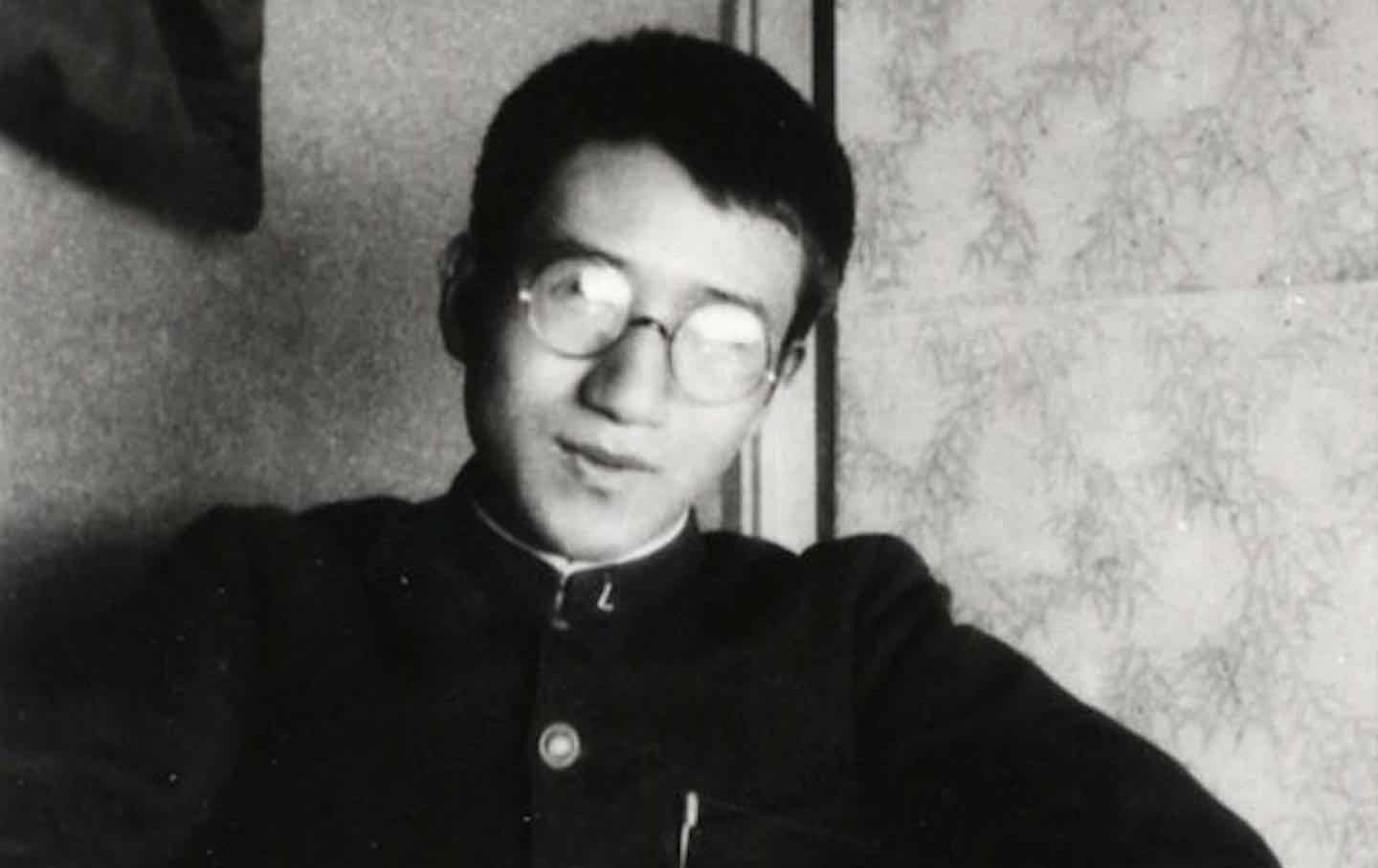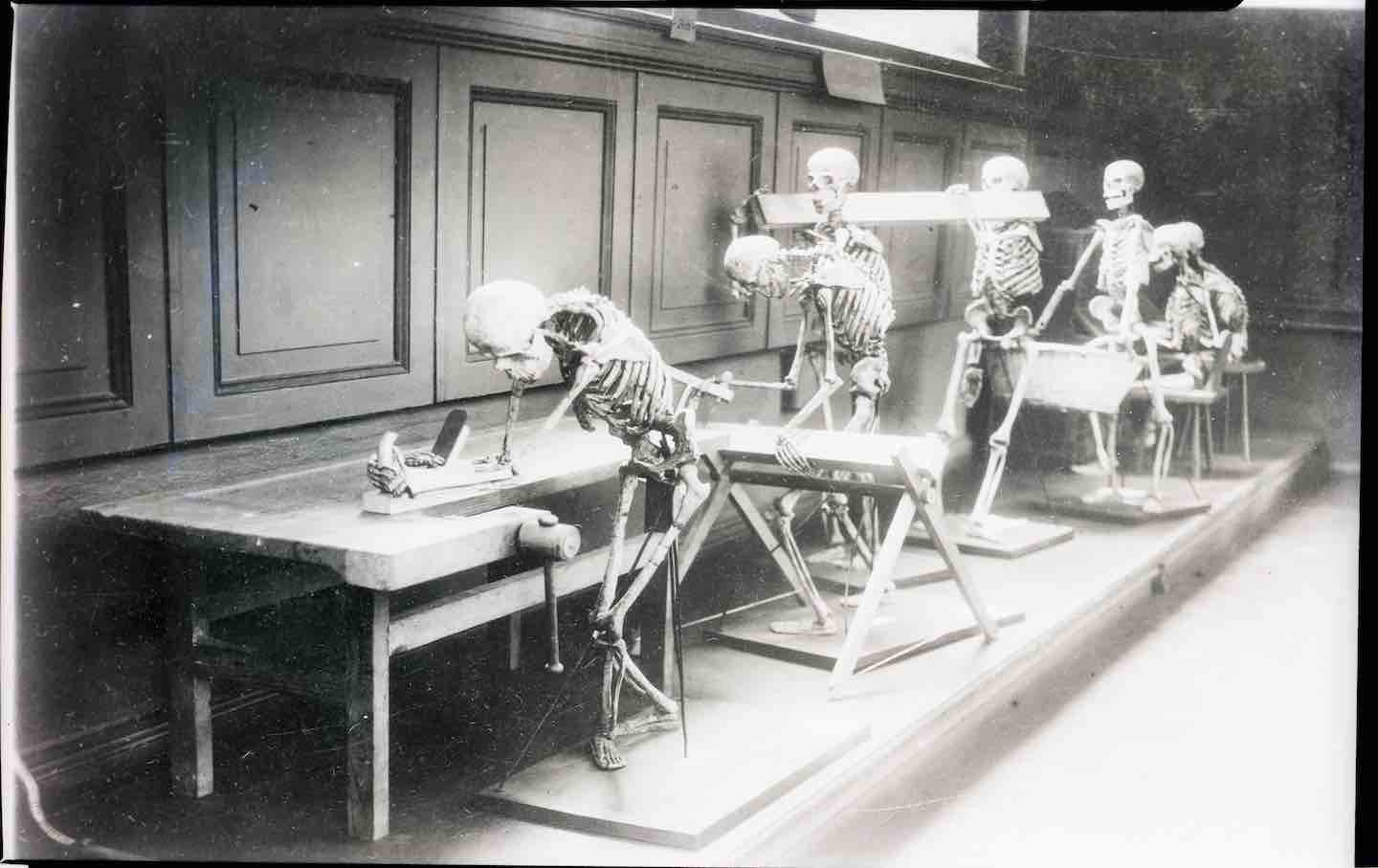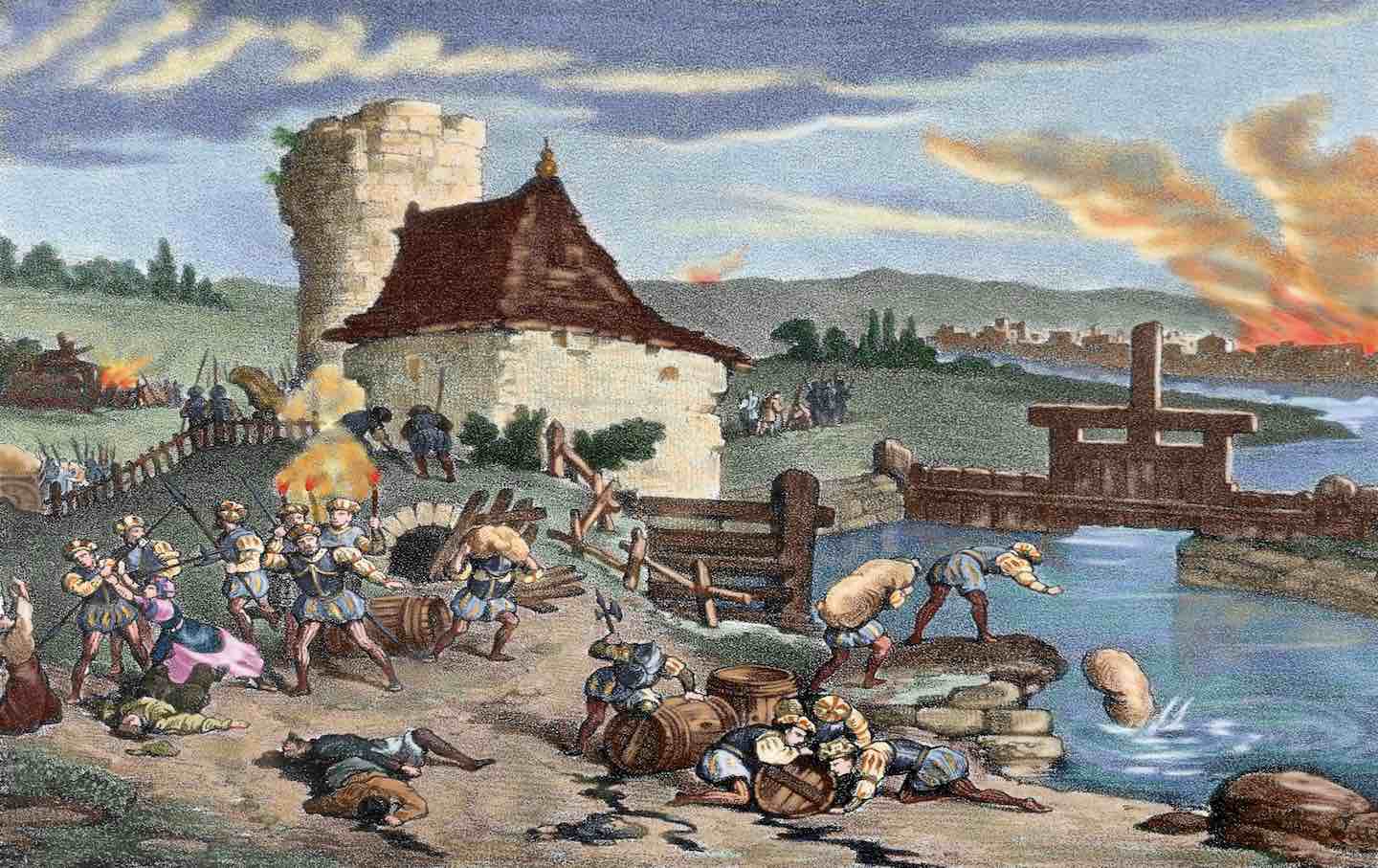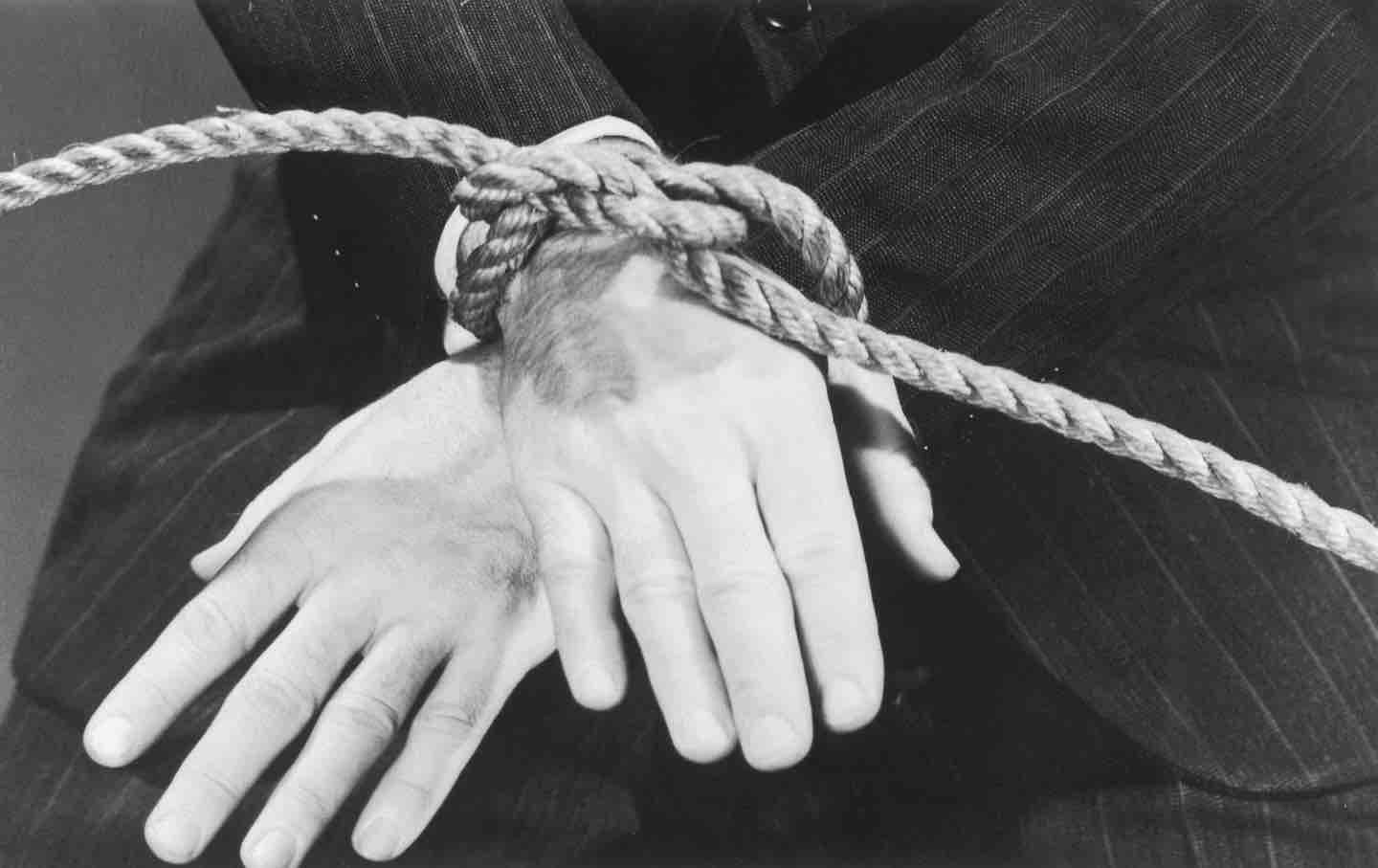The Ironist and the Exhibitionist: On Osamu Dazai
The Japanese novelist’s dark-hearted comedies are at once unhinged and brilliant.

Osamu Dazai, 1924.
(Courtesy of Wikimedia Commons)Where to begin the story? It’s tempting to start at the end—on the morning of Osamu Dazai’s 39th birthday, June 19, 1948, when his corpse was dredged from an irrigation canal outside Tokyo. Entangled with him was the body of Tomie Yamazaki, the war widow for whom he had abandoned his wife and children the year before.
Books in review
The Flowers of Buffoonery
Buy this bookAn apparent double suicide, it was a squalid but not surprising end for this youngest son of a downwardly mobile northern landowner. Eighteen years earlier, while a student at the University of Tokyo, Dazai—or rather Shuji Tsushima, as he was named in his family register—had taken an overdose of sleeping pills with a young woman he knew before plunging together into the sea. She drowned; he was saved. Other attempts would follow, both solo and with his first wife, but it was the November 1930 “incident at Kamakura” that, along with its final reenactment, formed the bookends of his brief adult life. In a similar way, Dazai’s two major literary treatments of the incident—1935’s The Flowers of Buffoonery and his posthumously published masterpiece, No Longer Human (1948)—could be said to bookend his writing life.
Now available for the first time in English in a translation by Sam Bett, the first of these works takes place in a coastal sanatorium south of Tokyo, where Yozo Oba, a 25-year-old art student, has just been brought after being pulled from the sea. (Sono, the young woman with him, did not survive.) The action, such as it is, finds Yozo visited by his friend Hida, an aspiring sculptor, and his relative Kosuge, a law student. Together, they pass the three days before their return to Tokyo like truant schoolboys: playing cards, cracking jokes, striking poses to impress the maid and the young woman patient in the next room, and generally avoiding the questions on everyone’s mind.
Already in this early work we see the rudiments of what Dazai would become: an unsettlingly unsettlingly comic writer whose gift lay in almost transgressing two fatal boundaries—between attempted and real suicide, and (what for him was effectively the same thing) between art and life. A pioneer of what Japanese critics call the “I-novel” (a form later taken up by his daughter, Yuko Tsushima), Dazai titillated his readers with apparent self-exposure, while preserving an ultimate deniability. His pseudonym and the trappings of fiction were flimsy disguises, but absolute distinctions. They allowed him, you might say, to be saved at the last moment.
But the real interest of Flowers goes beyond the resemblance between Dazai’s circumstances and those of his protagonist, Yozo. As he writes in the first chapter, “I might have skirted the whole issue by writing this in the first person, but this past spring I wrote a novel with a first-person narrator, so I’m hesitant to do another one so soon.” The obvious paradox here—who else is telling us this but a first-person narrator?—points to the book’s more authentic preoccupation, which is less with fiction’s relation to truth, than with how best its ambition might cannibalize truth and fiction alike.
“Welcome to sadness. Population one,” the book begins, and at once we are assailed by a singular voice—imperious, needy, and debased. Next comes a shocking confession: “I’ll tell you anything. It was me—these are the hands that pulled Sono underwater. In my satanic insolence, I prayed for my salvation in the same breath that I prayed Sono would die. Shall I go on?” the voice asks, before adding, with perfect disingenuousness: “But why bother, friends, if you’ll only look at me with pity in your eyes?”
Outrageous, exasperating, and, like so much of Dazai’s writing, indefinably (perhaps also indefensibly) charming, these narratorial intrusions are central to the book—and not just because they leave many chapters with a few bare sentences of narrative. The new angle they open onto the fictional world is also a new axis of conflict with the real one. To expose his own guilt, even in this fictional way, is also to implicate others—notably, his family, and the social apparatus in which they still played a prominent part. Crucially, however, Dazai will do so not by abandoning, but by intensifying, his aestheticism.
As soon becomes clear, Yozo’s stay in the sanatorium is not just meant to let him recover from nearly drowning; he is also being kept incommunicado while, behind the scenes, his older brother negotiates with the authorities to ensure a suitable legal outcome. After all, if Yozo had intended suicide and then been saved by happenstance, that would be one thing—but to have planned not to go through with it makes Sono’s death close to murder. The key confrontation is between Yozo and his brother after the latter has returned from speaking with the police and the dead woman’s husband. On the subject of Sono, Yozo’s brother is callous: He advises his dissolute sibling to “stick to the facts” in his police interview—that is, the official facts, which will likely be sufficient to get him off.
This conflict is classically Dazaian: Official society is revealed as unfeeling and corrupt, the man conscious of his crime as more innocent than those who knowingly cover it up. (Yozo’s brother saves the true shock for the end of their interview: The harvest has been bad, and the family’s fortunes are in decline. Yozo should prepare himself to have to work for a living.) But if Yozo regards his own actions with a kind of fascinated detachment, the others’ lack of curiosity is of a different order. In pressing him to declare that he meant to kill himself, they are, after all, pressing him to affirm the very thing—sincerity—that he is unable or unwilling to claim for himself.
By the end of the book, we learn that Yozo intends to stick to the “facts,” whatever they are. But this accommodation to the powers that be only sharpens the narrator’s motive for “revenge.” By blurting out everything, then taking it back with further disclosures, he shows that he isn’t to be trusted.
Yet, again, these confessions are strange: They are all but totally directed away from what Yozo meant or did and toward his anxieties about his art. The questions that really worry him are: Is this boring? Was what I just wrote clever or merely trite? The morality of writing—it must be interesting, it must hold nothing back—takes the place of social morality. Everything, for the reader of Dazai, will depend on how much one is charmed or repelled by this lurid brand of principle.
Irony and exhibitionism are the core of Dazai’s work. The same qualities are prominent in several of his contemporaries, and it is something of a mystery why the torrent of prose Dazai produced in his lifetime—novels, short stories, and essays, as well as tributes to cherished Western authors, including a version of Hamlet and various writings on François Villon—has never enjoyed the renown of his older contemporaries, like Jun’ichirō Tanizaki and Yasunari Kawabata, or his junior, Yukio Mishima. Yet whereas those writers meditated ruefully on the passing of feudal Japan, and the enticements and menace of a modernity that tended to wear a Western face, Dazai’s temperament was prevailingly modern.
Too honest with himself to wish for his country’s defeat in its war with the United States, he nonetheless expected to despise the Japan that would emerge from its victory. (The unforgettable scene in No Longer Human, in which the debauched young protagonist—again called Yozo Oba—vomits blood on the snow in the form of a rising sun puts paid to any notion of his creator’s reverence for national symbols.) Perhaps Dazai’s writing simply seemed too close to Western sensibilities, lacking the exoticism with which other Japanese writers of his era shocked or flattered domestic and international readers alike.
On the surface, this difference might be explained as a matter of politics. In The Flowers of Buffoonery, when Hida first tries to draw Yozo out by appealing to their common interests, he learns that his friend has turned against them. “Yozo was lured in by a certain brand of populist philosophy and became critical of fine art,” we are told. This “populist philosophy” is, of course, Marxism, to which Dazai was attracted during the 1930s, and which plays a role in most of his major writing.
Critics are divided on the sincerity of Dazai’s left-wing beliefs, though it’s hard to see why. Protagonists in his novels tend to deprecate their involvement in the Communist Party (which was banned in Japan in the 1930s) as a form of acting out. (In a secret meeting with the police arranged by his elder brother in 1932, Dazai repudiated leftist activities and never resumed them.) For his part, the Yozo of Flowers has absorbed the Marxist doctrines in a particularly jejune form. “Art is a proverbial turd, the byproduct of the socioeconomic complex,” he tells Hida. “Even the greatest masterpiece is no more than a commodity, like a pair of socks.” Rather than simply repudiating Yozo’s jaundiced view of art, however, Flowers transfigures it. Dazai’s narrator has not given up his hunger to produce a masterpiece. What he seeks is a new kind of masterpiece that would find its validity in degradation.
“To be a friend of the weak,” Dazai once wrote: “that is the artist’s point of departure, as well as his ultimate goal.” As the critic Makoto Ueda noted, this did not mean he was calling for an alliance between a landowner’s son like himself and the poor or working classes. (Dazai’s intuition, as a high school student, that there would be no place for him in a future communist state has been cited as the inspiration for his earliest suicide attempt; in his later years, he seems to have resigned himself on this point—though without losing the ironical view of social hierarchy that stemmed, in part, from awareness of his family’s peasant origins.) Instead, Dazai seems to have meant those who were weak in temperament, those unwilling or unable to lord it over others, who acknowledged and cultivated their own uselessness.
Popular
“swipe left below to view more authors”Swipe →These were, in the first instance, artists, though they might also be the wayward (though incipiently conformist) young bourgeois whom his early novella heroized (not altogether ironically) as “the ones who grow the delicate flowers of buffoonery, protecting them from the slightest gust of wind and always on the verge of despair!”
It would be in Dazai’s posthumously published No Longer Human that his performance of self-abasement reached its apex or nadir. In a reversal of the narrative frame of Flowers, No Longer Human presents itself as the found diaries of the now-deceased Yozo. Here, too, the protagonist makes a fool of himself for others’ benefit—though always haunted by the fear of being found out. When one of his schoolfellows, having sharply observed his latest tumble, tells him, “You did it on purpose,” he carries the shame for life—right up to the moment, after that book’s abortive joint suicide attempt, when an interrogating policeman asks him, “Was that real?”
Once again, the shame at a faulty performance of spontaneity seems to go deeper than the guilt at having possibly caused a woman’s death. But such shame is also a source of pride, as if Yozo’s inability to perform the simplest tasks—such as getting on a streetcar—without disabling self-consciousness conferred an indirect superiority to the human automata who do so without demur.
The Flowers of Buffoonery lacks both the extremity and the brilliance of such high misanthropy. Its narrator’s interruptions are fitful, never building the momentum of Dazai’s later tirades. Instead, it settles for anticlimax. In the final chapter, Yozo returns to the bluffs, now accompanied by Mano, the maid. He is set to return to Tokyo the next day. Mano, charmed by his kindness, tries to extract a promise that he will visit her, but he deflects. When they reach an outcrop from which she says they can see Mount Fuji, the view is blocked by fog. Not that Yozo cares. His thoughts are on the prosecutor back in Tokyo, whom he can already see in his mind’s eye winking at him, letting him off. Dazai, however, has one last trick up his sleeve: The book ends with Yozo staring down the cliff at the swirling sea—then the narrator breaks off: “No, that’s all I have.”
This literal cliffhanger finds Dazai—or his fictional stand-in—poised on the edge of his future work and (we can’t help thinking) of his future fate. The gesture is both irritating and thrilling, though it is also, in retrospect, quite flattering—since it was no romantic plunge into the sea that all but ensured Dazai’s works would be read as suicide notes. You could say that The Flowers of Buffoonery frustrates such a literal reading, though it clearly also prompts it. At its best, however, Dazai’s unhinged art might convince us that brute facts are the beginning, not the end, of understanding him.
We cannot back down
We now confront a second Trump presidency.
There’s not a moment to lose. We must harness our fears, our grief, and yes, our anger, to resist the dangerous policies Donald Trump will unleash on our country. We rededicate ourselves to our role as journalists and writers of principle and conscience.
Today, we also steel ourselves for the fight ahead. It will demand a fearless spirit, an informed mind, wise analysis, and humane resistance. We face the enactment of Project 2025, a far-right supreme court, political authoritarianism, increasing inequality and record homelessness, a looming climate crisis, and conflicts abroad. The Nation will expose and propose, nurture investigative reporting, and stand together as a community to keep hope and possibility alive. The Nation’s work will continue—as it has in good and not-so-good times—to develop alternative ideas and visions, to deepen our mission of truth-telling and deep reporting, and to further solidarity in a nation divided.
Armed with a remarkable 160 years of bold, independent journalism, our mandate today remains the same as when abolitionists first founded The Nation—to uphold the principles of democracy and freedom, serve as a beacon through the darkest days of resistance, and to envision and struggle for a brighter future.
The day is dark, the forces arrayed are tenacious, but as the late Nation editorial board member Toni Morrison wrote “No! This is precisely the time when artists go to work. There is no time for despair, no place for self-pity, no need for silence, no room for fear. We speak, we write, we do language. That is how civilizations heal.”
I urge you to stand with The Nation and donate today.
Onwards,
Katrina vanden Heuvel
Editorial Director and Publisher, The Nation
More from The Nation

The Perils of a Post-Racial Utopia The Perils of a Post-Racial Utopia
In Nicola Yoon’s One of Our Kind, a dystopian novel of a Black upper-class suburb’s secrets, she examines the dangers of choosing exceptionalism over equality.

Why Americans Are Obsessed With Poor Posture Why Americans Are Obsessed With Poor Posture
A recent history of the 20th-century movement to fix slouching questions the moral and political dimensions of addressing bad backs over wider public health concerns.

Thomas Müntzer’s Misunderstood Revolution Thomas Müntzer’s Misunderstood Revolution
A recent biography of the German preacher and leader of the Peasants’s War examines what remains radical about the short-lived rebellion he led.

Is It Possible to Suspend Disbelief at Ayad Akhtar’s AI Play? Is It Possible to Suspend Disbelief at Ayad Akhtar’s AI Play?
The Robert Downey Jr.–starring McNeal, which was possibly cowritten with the help of AI, is a showcase for the new technology’s mediocrity.

Possibility, Force, and BDSM: A Conversation With Chris Kraus and Anna Poletti Possibility, Force, and BDSM: A Conversation With Chris Kraus and Anna Poletti
The two writers discuss the challenges of writing about sex, loneliness, and the new ways novels can tackle BDSM.

Lore Segal’s Stubborn Optimism Lore Segal’s Stubborn Optimism
In her life and work, she moved through the world with a disarming blend of youthful curiosity and daring intelligence.


